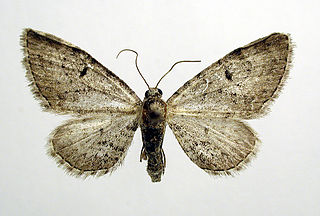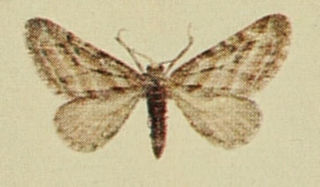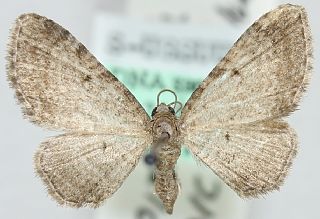
The lime-speck pug is a moth of the family Geometridae. It is a common species throughout the Palearctic region, the Near East and North Africa.

The wormwood pug is a moth of the family Geometridae. The species was first described by Carl Alexander Clerck in 1759. It is a common species across the Palearctic region as well as North America.

The grey pug is a moth of the family Geometridae. It is found throughout the Palearctic region. It is also found in North America. Since it does not place any special demands on climatic conditions, special caterpillar food plants, geological subsoil or the like it is a typical species of almost any Hochstaudenflur, where it occurs in the herb layer, in bushes and even on deciduous trees. It can be found on forest edges and hedgerows, on heath, in rocky places and wetlands, parks and gardens, as well as in villages and town centres.

The goldenrod pug is a moth of the family Geometridae. The species was first described by Henry Doubleday in 1861. It is found throughout the Palearctic region. In the British Isles it is widespread but rather locally distributed.

Eupithecia satyrata, the satyr pug, is a species of moth of the family Geometridae. It was described by Jacob Hübner in 1813. It is found from Ireland, through northern and central Europe east to all of Russia and central Asia and western Siberia to Tibet. It is also present in North Africa and North America.

Eupithecia pimpinellata, the pimpinel pug, is a moth of the family Geometridae. The species was first described by Jacob Hübner in 1813. It is known from most of Europe to Morocco, Siberia, Kyrgyzstan, Altai, Mongolia.It primarily colonizes bushy places, forest edges, clearings, hedges, mountain slopes, embankments, railway dams and parks as well as semi-dry grasslands. In the Alps it rises to heights of 1800 metres.

Eupithecia selinata is a moth of the family Geometridae. It is found from Japan through the Amur Region, Siberia, the Urals, Caucasus and Russia to western Europe and from southern Fennoscandia to the Alps.

Eupithecia extensaria, the scarce pug, is a moth of the family Geometridae. The species was first described by Christian Friedrich Freyer in 1844. It is found in the British Isles, Spain and eastern Europe.

Eupithecia addictata is a moth in the family Geometridae. It is found from north-eastern Italy, through Austria, northern Hungary and southern Slovakia to Ukraine, Russia and Japan. It is also found in the southern Balkan Peninsula.
Eupithecia alliaria is a moth in the family Geometridae. It is found from France and the Iberian Peninsula east through south-central Europe to Russia and most of the Balkan Peninsula. It is also found in the Near East and North Africa.
Eupithecia mystica is a moth in the family Geometridae. It is found in Ukraine, North Macedonia, Greece and Romania.
Eupithecia undata is a moth in the family Geometridae first described by Christian Friedrich Freyer in 1840. The North American Moth Photographers Group lists it as a synonym of Eupithecia lafontaineata. It is found in the Pyrenees, Alps, the Massif Central, the Tatra mountains, on the Balkan Peninsula and in Romania. It is also found in North America, where it has been recorded from Wyoming, Montana, Idaho, Colorado, Nevada and Oregon.
Eupithecia graphata is a moth in the family Geometridae. bIt was described by Treitschke in 1828. It is found in most of southern and eastern Europe, as well as the Near East.
Eupithecia deverrata is a moth in the family Geometridae. It is found from Morocco to Lebanon.
Eupithecia orana is a moth in the family Geometridae. It is found on the Canary Islands and in Spain and North Africa.
Eupithecia suspiciosata is a moth in the family Geometridae. It was described by Karl Dietze from the US state of California.
Eupithecia sardoa is a moth in the family Geometridae. It is found in North Africa and on Corsica and Sardinia. It was recently recorded from the Parco Naturale della Maremma in Italy.
Eupithecia unitaria is a moth in the family Geometridae. It is found in Spain and North Africa.
Eupithecia bastelbergeri is a moth in the family Geometridae. It is found in Kazakhstan, Kyrghyzstan, Russia, Iran and Turkey.
Eupithecia elissa is a moth in the family Geometridae first described by Karl Dietze in 1910. It is found in Tunisia.









